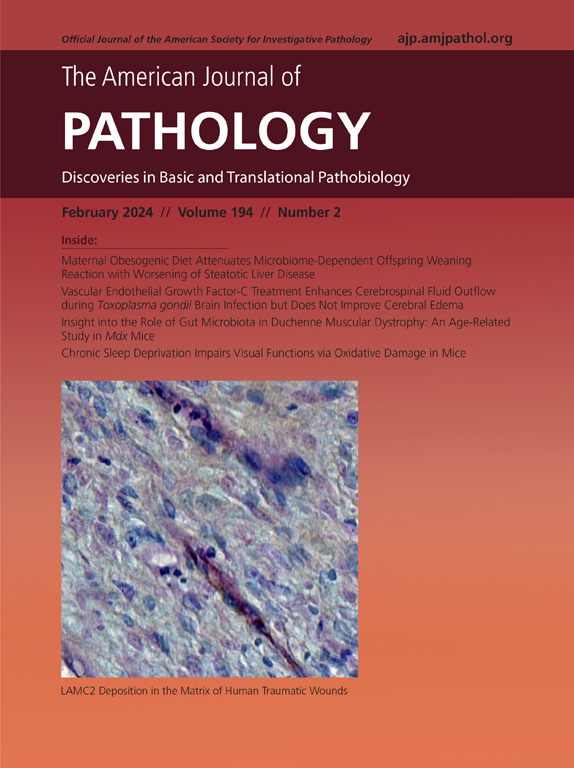转录因子YY2通过调节GLS1 RNA剪接异构体GAC抑制肿瘤细胞谷氨酰胺分解代谢。
IF 3.6
2区 医学
Q1 PATHOLOGY
引用次数: 0
摘要
氨基酸的代谢重编程对肿瘤的发生至关重要。在肿瘤中经常观察到氨基酸代谢的改变,这对于满足肿瘤细胞大分子生物合成、氧化还原平衡和能量产生的需求至关重要。尽管它很重要,但调节肿瘤细胞氨基酸代谢重编程的机制尚未完全阐明。在结直肠癌和肝癌细胞中,我们发现阴阳2 (YY2)通过降低GLS1剪接异构体谷氨酰胺酶C的表达,显著降低了谷氨酰胺酶1 (GLS1)的转录活性,GLS1是将谷氨酰胺水解为谷氨酸的酶。反过来,这促进了谷氨酰胺的积累,同时降低了谷氨酸的积累,导致DNA和从头合成谷胱甘肽的下降,随后是肿瘤细胞增殖和抗氧化能力的降低。随后,我们发现YY2/ gls1介导的谷氨酰胺分解代谢抑制显著抑制了体内的致瘤潜能。关键的是,经常在临床肿瘤样本中发现的突变体YY2未能发挥这种作用。总之,这些结果确定YY2/谷氨酰胺酶C是肿瘤细胞中谷氨酰胺分解代谢的负调节因子,并揭示了YY2抑制肿瘤作用的新分子机制。此外,这些发现表明YY2可以作为一种靶向谷氨酰胺代谢的抗肿瘤药物。本文章由计算机程序翻译,如有差异,请以英文原文为准。

Transcription Factor YY2 Inhibits Tumor Cell Glutamine Catabolism by Regulating GLS1 RNA Splicing Isoform GAC
The metabolic reprogramming of amino acids is critical for tumorigenesis. Alterations in amino acid metabolism are frequently observed in tumors and are crucial for fulfilling the demand for macromolecular biosynthesis, redox balance, and energy production in tumor cells. Despite its importance, the mechanism regulating amino acid metabolic reprogramming in tumor cells has not been completely elucidated. Herein, colorectal cancer and hepatocarcinoma cells were used to show that Yin yang 2 (YY2) significantly reduced the transcriptional activity of glutaminase 1 (GLS1), which hydrolyzes glutamine to glutamate, by decreasing the expression of glutaminase C, a splicing isoform of GLS1. This, in turn, promoted glutamine accumulation while decreasing that of glutamate, leading to a drop in DNA and de novo glutathione synthesis, followed by a reduction in tumor cell proliferation and antioxidant capacity. Subsequently, YY2/GLS1–mediated inhibition of glutamine catabolism significantly suppressed tumorigenic potential in vivo. Critically, mutant YY2, often found in clinical tumor samples, failed to exert this effect. Together, these results identified YY2/glutaminase C as a negative regulator of glutamine catabolism in tumor cells and revealed a novel molecular mechanism underlying the tumor-suppressive effect of YY2. Moreover, these findings suggest that YY2 could serve as an antitumor therapeutic agent by targeting glutamine metabolism.
求助全文
通过发布文献求助,成功后即可免费获取论文全文。
去求助
来源期刊
CiteScore
11.40
自引率
0.00%
发文量
178
审稿时长
30 days
期刊介绍:
The American Journal of Pathology, official journal of the American Society for Investigative Pathology, published by Elsevier, Inc., seeks high-quality original research reports, reviews, and commentaries related to the molecular and cellular basis of disease. The editors will consider basic, translational, and clinical investigations that directly address mechanisms of pathogenesis or provide a foundation for future mechanistic inquiries. Examples of such foundational investigations include data mining, identification of biomarkers, molecular pathology, and discovery research. Foundational studies that incorporate deep learning and artificial intelligence are also welcome. High priority is given to studies of human disease and relevant experimental models using molecular, cellular, and organismal approaches.

 求助内容:
求助内容: 应助结果提醒方式:
应助结果提醒方式:


